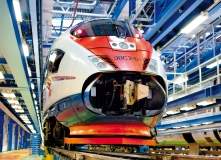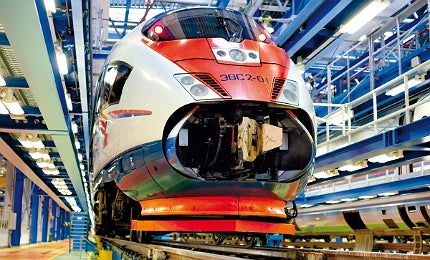

As 21st century Russia continues to improve its economic outlook and trade potential, the freight and passenger rail infrastructure of the world’s largest country is playing a key strategic role; far more so than the relatively small western European states or the auto-addicted US.
In a country where the efficient transportation of freight and passengers across immense distances is essential for the development of profitable domestic and foreign trade, as well as the geographic mobility of its citizens, it’s no surprise that Russia operates the world’s second-largest rail network. Spanning more than 85,000km of track, Russia’s railways account for nearly 90% of the country’s freight movements, excluding pipelines.
While Russia’s enormous rail network is central to the country’s economic future, its ageing and often obsolete infrastructure and vehicles also represent a significant impediment to growth, especially in the transit and export of valuable commodities. A history of underinvestment has left a legacy of inefficiency and severe transport bottlenecks on the capacity-strained network, stifling the ability of Russian companies to get key exports such as coal to major customers in Asia and Europe.
The cost of transporting coal from mines to ports by rail is among the highest in the world in Russia, with prices of $80-90 per tonne, bringing exporters perilously close to the break-even point. February 2013 brought a costly example of the economic effects of poor rail infrastructure in Russia, as 260 rail cars transporting oil products for export were held up for days by poor technical equipment.
See Also:
Russia’s sweeping rail reforms
In response to these challenges, Russia and its state-owned railway monopoly Russian Railways (RZD) are in the midst of a long series of dramatic reforms to overhaul rail infrastructure. The process started with the Railway Structural Reform Programme, which kicked off in 2001 with the creation of RZD (which inherited all assets and operations of the previous Ministry of Railways) and a plan to reorganise and part-privatise Russia’s rail industry.
How well do you really know your competitors?
Access the most comprehensive Company Profiles on the market, powered by GlobalData. Save hours of research. Gain competitive edge.

Thank you!
Your download email will arrive shortly
Not ready to buy yet? Download a free sample
We are confident about the unique quality of our Company Profiles. However, we want you to make the most beneficial decision for your business, so we offer a free sample that you can download by submitting the below form
By GlobalDataThe country’s rail reform plans were given a further shot in the arm in 2008, with the ratification of the Strategy for Developing Rail Transport in the Russian Federation up to 2030.
This hugely ambitious modernisation plan for the coming decades involves some mind-boggling numbers for implementation by 2030, including the construction of up to 20,000km of new routes, the upgrade of 13,800km of freight lines for heavy axle loads, as well as the acquisition of 23,300 modern locomotives, 29,500 passenger cars and nearly a million freight cars.
Major projects and goals
The development of Russia’s high-speed rail services is central to its modernisation of passenger lines. High-speed rail has already been tentatively introduced in the form of the Sapsan high-speed service between St. Petersburg and Moscow, which opened in 2009, but as it shares existing rail lines with slower and more affordable services, the regularity of the high-speed train was reduced in 2012 to allow a higher proportion of cheaper fares.
RZD is planning a $35bn dedicated high-speed corridor between the two cities, but the timeline for its construction is still unclear, as the rail company is waiting for the proper funding arrangements. By the end of 2015, RZD aims to have more than 2,500km of high-speed rail running between Moscow and Kiev, Minsk and Kursk.
As for freight, RZD’s upgrades and modernisation projects, as well as the acquisition of all that rolling stock, are intended to position Russia not only as a major exporter to its Asian and European neighbours, but also as a ‘land bridge’ between them.
The company is working to improve major east-west freight corridors, such as the Trans-Siberian Railway, to bolster the country’s reputation as an inexpensive and speedy means to transport freight between Asia and Europe. RZD’s project to reduce the Trans-Siberian transit time to seven days is due to be completed in 2015, and the current average travel time is fewer than eight days, with an average speed of around 1,200km per day.
"The Trans-Siberian Railway is now one of the busiest in the world and in the future will be used by more than a hundred pairs of passenger and freight trains every day," said RZD’s outspoken president Vladimir Yakunin in March 2013. "We plan to invest about $6bn in the development of the Trans-Siberian railway by 2020.
"We offer our partners a new level of transport services which are showing steady growth. Between 2009 and 2012, the volume of transit traffic increased from 22 million tonnes to 33 million tonnes. The transportation of large containers is growing even faster. In 2012, transit container traffic doubled in comparison with 2009 to 238,200 twenty-foot equivalent units (TEUs), including 48,300 TEUs in the strategic east-west direction."
Opening up to foreign investment
Clearly, RZD’s enormous rail modernisation programme is already achieving results and paints a bright picture of the network’s future. But the programme’s mind-boggling numbers are joined by mind-boggling costs – RZD estimates that at least RUB11 trillion (approximately $353bn) will need to be invested in Russian rail to achieve its 2030 goals.
Even with the backing of the Russian federal and regional budgets, it’s clear that RZD will be unable to meet all of these costs. So how will this host of projects get funded? Russia’s answer, or at least part of its answer, is to open up to foreign investment, which brings the additional benefit of leveraging foreign expertise and technology to modernise infrastructure and rolling stock.
Russia is reaching out primarily to Europe for investment and partnership in the development of its network, as evidenced by the recent (and well-received) Eurobond issues of RZD. And Europe is responding in turn – the European Bank for Reconstruction and Development (EBRD) has invested more than $1.6bn in 13 Russian rail projects since the network’s 21st century reform kicked off in 2001. One of the most recent EBRD investments was a $78.6m loan to Russian private rail freight group Globaltrans in 2012, to part-fund the acquisition of 10,000 modern rail cars.
RZD and other Russian groups have partnered with a number of major European rail companies, particularly for the production of new locomotives and rail cars. German rail manufacturer Siemens provided the rolling stock for Russia’s high-speed Sapsan service with a modified version of its Velaro platform. Along with the eight trains currently running between Moscow and St Petersburg, RZD contracted Siemens for a further eight Velaro units in December 2011.
Alstom handed over the first series production EP20 electric passenger locomotive to RZD” height=”300″ src=”https://www.railway-technology.com/wp-content/uploads/static-progressive/Alstom_TMH_locomotive_Russia’s%20railways.jpg” title=”In November 2012, TMH and Alstom handed over the first series production EP20 electric passenger locomotive to RZD” width=”430″ />
In November 2012, TMH and Alstom handed over the first series production EP20 electric passenger locomotive to RZD
More than simply providing technology for Russian projects, European companies are increasingly forming joint ventures with their Russian counterparts to trade their technical nous and financial investment for a larger presence in the country’s lucrative rail market.
Siemens itself entered a joint venture with Russian investment company Sinara Group to form Train Technologies in 2011. The new company has set up a production plant in the Russian city of Yekaterinburg, and is supplying 240 modified Desiro train sets to RZD for regional services during the coming years, with the first trains set to go into service in Sochi in autumn 2013.
French rail giant Alstom Transport has invested a similarly large stake in Russian rolling stock development with its partnership with the country’s leading rail manufacturer Transmashholding (TMH). Alstom acquired a 25% stake in TMH – equal to RZD’s own shares in the company – for $425m in 2011, with a plan to jointly develop and manufacture freight and passenger locomotives for the Russian market.
In November 2012, TMH and Alstom handed over the first series production EP20 electric passenger locomotive to RZD at the companies’ Novocherkassk facility in the Rostov region. Three units per month are being delivered to Russian Railways up until the end of 2013, and the trains will be operated on the Moscow – Sochi line in time for the 2014 Winter Olympics.
As well as directly working with TMH on the development of the locomotives, Alstom introduced new technologies to the company and has trained 80 Russian engineers to design and test locomotives using modern computer systems. It appears that European companies are willing to invest their cash, technologies and expertise to widen their slice of the Russian rail pie.
It’s a fact that a great deal of work still remains if Russia wants to take full advantage of its rail network throughout the coming decades. Privatisation of RZD and many of its subsidiaries and assets remains a point of contention, with senior government officials and RZD’s Yakunin butting heads over how much to privatise, and how fast.
Although privatisation is a fast-track method of unlocking the private investment needed to make up Russia’s rail funding shortfall, Yakunin has expressed concern about the instability of the global economy and has previously cited the potential benefits of following China’s model of maintaining control over its railways as a strategic industry. The Russian Government wants to privatise 25% minus one share of RZD by the end of 2013, but both Yakunin and Transport Minister Maxim Sokolov have called the plan unrealistic.
Nevertheless, Russia’s rail network is improving at a steady pace as investment – foreign and domestic, public and private – continues. Whatever Russia decides on regarding privatisation, foreign participation and other issues, when it comes to completely overhauling one of the world’s largest rail networks, it’s the money that counts.
Related content
China’s high-speed rail revolution
While other countries still debate high-speed rail, it is already reality in China. But have recent corruption allegations and growing concerns about the safety of the high-speed rail network cast a shadow that could prevent future progress of the projects?
Siemens Velaro High Speed Trains, Germany
Velaro is the world’s fastest high-speed train, developed by Germany-based company Siemens. The trains are manufactured at the Krefeld-Uerdingen factory in Germany. They could be a potential alternative to aircraft and cars in future.




